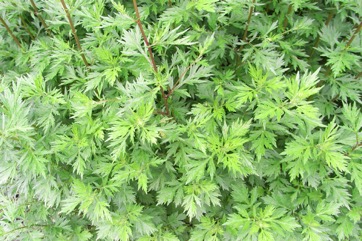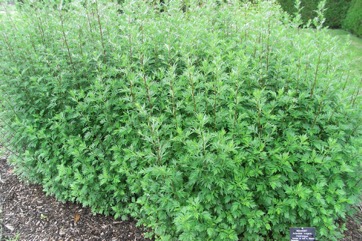Mugwort, Artemisia shoot, Slender artemisia

A temperate plant. It will grow on most soils. It will grow in poor soils. It will resist drought and frost. It grows on roadsides, slopes, canyons, forest margins, forest steppe, sub-alpine steppe between 100-3800 m altitude in China. It grows along the banks of streams. It suits hardiness zones 3-10.
Also known as:
Arbaaka, Chinese moxa, Darmong maria, Davanamu, Dayona, Dhordavana, Divlji pelin, Fellon-herb, Felon herb, Koadchula, Laibakngou, Machipatri, Me-di-dok, Metlika, Mulssuk, Nagadamani, Nagdona, Nagodoyana, Navadni pelin, Ngaai, Ngai cuu, Pelynek cemobyl, Sagebrush, Thit-nan-gaing, Tinisas, Yomogi
Synonyms
- Artemisia selengensis var. selengensis
- Many
Edible Portion
- Plant, Herb, Spice, Leaves
Where does Mugwort grow?
Found in: Afghanistan, Africa, Asia, Australia, Balkans, Belarus, Bosnia, Brazil, Britain, Canada, Caucasus, China, Cuba, Czech Republic, Europe, France, Georgia, Germany, Haiti, Hawaii, Himalayas, India, Indochina, Indonesia, Iran, Ireland, Italy, Japan, Korea, Kyrgyzstan, Laos, Lithuania, Luxembourg, Macedonia, Malaysia, Mongolia, Myanmar, North Africa, North America, Northeastern India, Norway, Pacific, Pakistan, Philippines, Russia, Scandinavia, SE Asia, Siberia, Slovenia, South America, Spain, Sweden, Tasmania, Thailand, SW Asia, United States, Vietnam
Notes: There are about 300 Artemisia species.
Growing Mugwort, Artemisia shoot, Slender artemisia
Cultivation: It is grown from seed or cuttings.
Edible Uses: It is used as a seasoning for roast meat, especially fatty poultry. It is also used to flavour soups. Mugwort was used to flavour beer before hops were introduced. The leaves are boiled and eaten as a potherb. They are also used to give flavour and colour to rice cakes. The dried leaves and tops are used to flavour beer or steeped into tea. The roots are cooked and eaten. The tender leafless shoots are gathered as they emerge and eaten as a delicacy.
Production: The tips of the young plants are harvested before the flower buds open. (It becomes bitter after this.) Leaves can be dried.
Nutrition Info
per 100g edible portion| Edible Part | Energy (kcal) | Protein (g) | Iron (mg) | Vitamin A (ug) | Vitamin c (mg) | Zinc (mg) | % Water |
|---|---|---|---|---|---|---|---|
| Leaves - flavour | 35 | 5.2 | 1.5 | - | - | - | 87.3 |
Mugwort, Artemisia shoot, Slender artemisia Photos


References
Ambasta S.P. (Ed.), 2000, The Useful Plants of India. CSIR India. p 56
Bircher, A. G. & Bircher, W. H., 2000, Encyclopedia of Fruit Trees and Edible Flowering Plants in Egypt and the Subtropics. AUC Press. p 42
Bodkin, F., 1991, Encyclopedia Botanica. Cornstalk publishing, p 105
Bremness, L., 1994, Herbs. Collins Eyewitness Handbooks. Harper Collins. p 151
Brouk, B., 1975, Plants Consumed by Man. Academic Press, London. p 312
Brown, D., 2002, The Royal Horticultural Society encyclopedia of Herbs and their uses. DK Books. p 133
Cerne, M., 1992, Wild Plants from Slovenia used as Vegetables. Acta Horticulturae 318
Crate, S. A., 2008, "Eating Hay": The Ecology, Economy and Culture of Viliui Sakha Smallholders of Northeastern Siberia. Human Ecology 36:161-174
Cundall, P., (ed.), 2004, Gardening Australia: flora: the gardener's bible. ABC Books. p 191
Esperanca, M. J., 1988. Surviving in the wild. A glance at the wild plants and their uses. Vol. 1. p 272
Facciola, S., 1998, Cornucopia 2: a Source Book of Edible Plants. Kampong Publications, p 34
Fan, L., et al, The Use of Edible Wild Plants and Fungi in Korean-Chinese Villages. Journal of Environmental Information Science 44-5 p 71-79 (As Artemisia selengensis)
Food Composition Tables for use in East Asia FAO http://www.fao.org/infoods/directory No. 805
Hedrick, U.P., 1919, (Ed.), Sturtevant's edible plants of the world. p 75
Hibbert, M., 2002, The Aussie Plant Finder 2002, Florilegium. p 33
http://nordicfood lab/org/blog/2102/9/wild-edible-plants-an-overview
Hu, Shiu-ying, 2005, Food Plants of China. The Chinese University Press. p 719 (As Artemisia selengensis)
Irving, M., 2009, The Forager Handbook, A Guide to the Edible Plants of Britain. Ebury Press p 140
Jiwajinda, S., et al, 2002, Suppressive Effects of Edible Thai Plants on Superoxide and Nitric Oxide Generation. Asian Pacific Journal of Cancer Prevention, Vol 3, 2002
Lim, T. K., Edible Medicinal and Non-Medicinal Plants Volume 7 Flowers
Pemberton, R. W. & Lee, N. S., 1996, Wild Food Plants in South Korea: Market Presence, New Crops, and Exports to the United States. Economic Botany, Vol. 50, No. 1, pp. 57-70 (As Artemisia selengensis)
Kiple, K.F. & Ornelas, K.C., (eds), 2000, The Cambridge World History of Food. CUP p 433, 1817
Kybal, J., 1980, Herbs and Spices, A Hamlyn Colour Guide, Hamlyn Sydney p 50
Ling Yuou-ruen & C. J. Humphries, ASTERACEAE (Draft), Tribe ANTHEMIDEAE Cassini, in Flora of China
MacKinnon, A., et al, 2009, Edible & Medicinal Plants of Canada. Lone Pine. p 370
Martin, F.W. & Ruberte, R.M., 1979, Edible Leaves of the Tropics. Antillian College Press, Mayaguez, Puerto Rico. p 105, 184
Plants for a Future database, The Field, Penpol, Lostwithiel, Cornwall, PL22 0NG, UK. http://www.scs.leeds.ac.uk/pfaf/
Plants of Haiti Smithsonian Institute http://botany.si.edu
PROSEA handbook Volume 13 Spices. p 274
Redzic, S. J., 2006, Wild Edible Plants and their Traditional Use in the Human Nutrition in Bosnia-Herzegovina. Ecology of Food and Nutrition, 45:189-232
Redzic, S., 2010, Use of Wild and Semi-Wild Edible Plants in Nutrition and Survival of People in 1430 Days of Siege of Sarajevo during the War in Bosnia and Herzegovina (1992–1995). Coll. Antropol 34 (2010) 2:551-570
S.C.A.P.;
Seidemann J., 2005, World Spice Plants. Economic Usage, Botany, Taxonomy. Springer. p 57
Simkova, K. et al, 2014, Ethnobotanical review of wild edible plants used in the Czech Republic. Journal of Applied Botany and Food Quality 88, 49-67
Singh, P.K., Singh, N.I., and Singh, L.J., 1988, Ethnobotanical Studies on Wild Edible Plants in the Markets of Manipur - 2. J. Econ. Tax. Bot. Vol. 12 No. 1 pp 113-119
Soukand, R., et al, 2017, Multi-functionality of the few: current and past uses of wild plants for food and healing in Liubań region, Belarus. Journal of Ethnobiology and Ethnomedicine (2017) 13:10
Sp. pl. 2:848. 1753
Staples, G.W. and Herbst, D.R., 2005, A tropical Garden Flora. Bishop Museum Press, Honolulu, Hawaii. p 154
Stern, G., 1986, Australian Weeds. A Source of Food and Medicine. Harper & Row. p 133
Sukarya, D. G., (Ed.) 2013, 3,500 Plant Species of the Botanic Gardens of Indonesia. LIPI p 1065
Terra, G.J.A., 1973, Tropical Vegetables. Communication 54e Royal Tropical Institute, Amsterdam, p 25
Tronickova, E. & Krejcova, Z., 1987, Ortaggi, Instituto Geografico de Agostini, Cecoslovacchia. p 192
UPHOF
Urgamal, M., Oyuntsetseg, B., Nyambayar, D. & Dulamsuren, Ch. 2014. Conspectus of the vascular plants of Mongolia. (Editors: Sanchir, Ch. & Jamsran, Ts.). Ulaanbaatar, Mongolia. “Admon“ Press. 334pp. (p. 199-230).
Van Sam, H. et al, 2008, Uses and Conservation of Plant Species in a National Park. A case study of Ben En, Vietnam. Economic Botany 62:574-593
Wilson, S., 1997, Some Plants are Poisonous. Reed. p 24
World Checklist of Useful Plant Species 2020. Royal Botanic Gardens, Kew
Wujisguleng, W., & Khasbagen. K., 2010, An integrated assessment of wild vegetable resources in Inner Mongolian Autonomous Region, China. Journal of Ethnobiology and Ethnomedicine 6:34 (As Artemisia selengensis)
www.wildediblefood.com
Young, J., (Ed.), 2001, Botanica's Pocket Trees and Shrubs. Random House. p 107